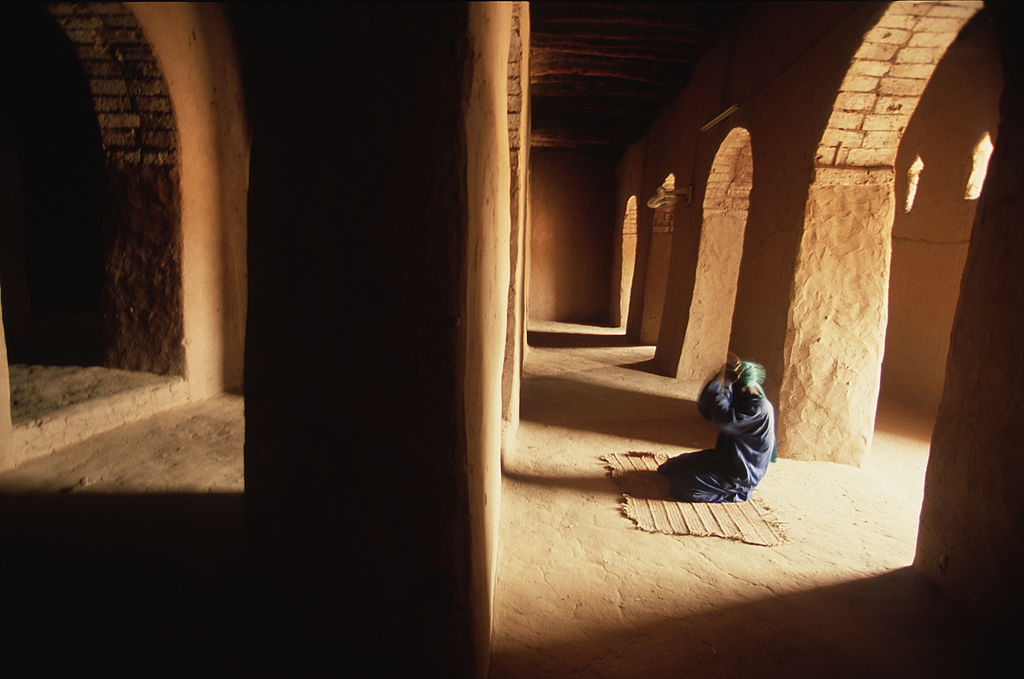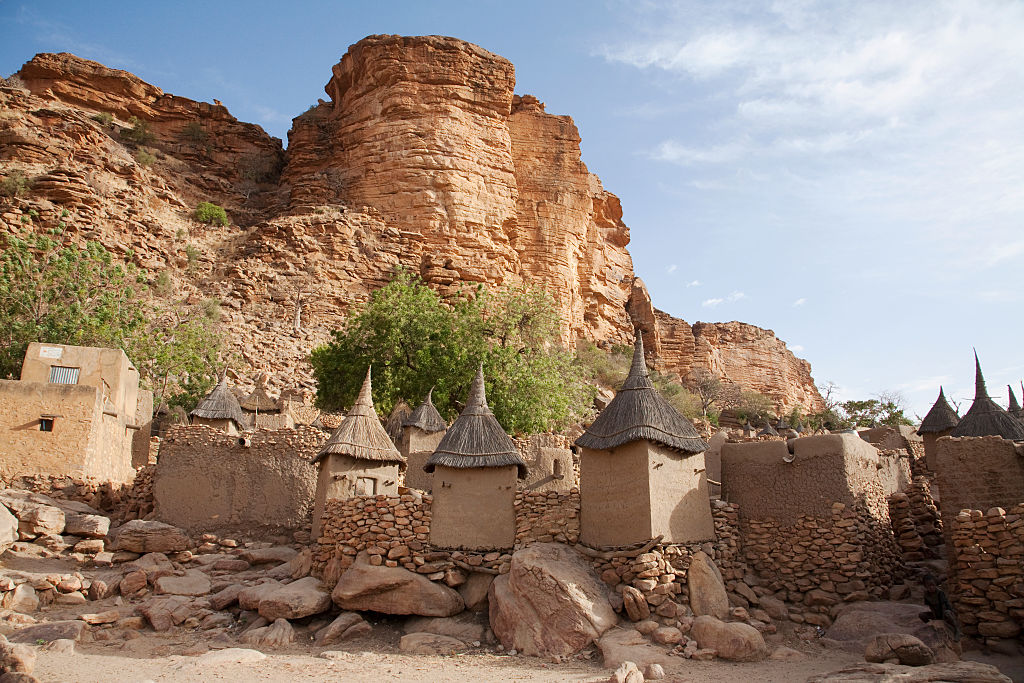
A dozen Chinese tourists, armed with their cameras, are capturing the sights, standing on sandstone cliffs looking over dusty plains 1500 feet below. The sky is clear: in the distance, hundreds of villages on the plains of Dogon country stretch as far as the horizon.
Behind them, hardly visible, a handful of Malian soldiers wait with assault rifles at the ready. Their military green outfits and flak jackets blend in with the light brown cliffs.
The tourists take pictures of the view and pose with the villagers who welcomed them earlier with a few songs, an activity organized by Mali’s Ministry of Tourism, which says it wants to show visitors “the real Africa.” Then they return to their convoy of vehicles, surrounded by armed men dispatched by the government to ensure their protection.
Just four days before their arrival, an hour’s drive south in Bankass, armed men slit the throat of a nearby village chief before carrying his lifeless body away on a motorbike.
The Bandiagara cliffs, in central Mali, are one of West Africa’s most renowned tourist attractions. Today, they are at the heart of the new frontline of Mali’s 7-year-long conflict. Over 500 people have died in the violence in central Mali in the past six months alone, where the rise of Islamist extremist groups and ethnic militias has turned into deadly violence between Fulani herders and Dogon and Bambara farmers.
In March, 160 Fulani civilians — among them children, pregnant women, elderly people — were killed in their homes in the Ogossagou village by suspected Dogon militiamen. On June 10, at least 35 Dogon civilians were shot and burned alive in their village by suspected Fulani militiamen, only a few miles away from the cliffs.
The trip is part of the government’s latest strategy to revive a once-thriving tourist industry. A decade ago, people came from all over the world to see Mali’s landscapes and monuments, which include four UNESCO World Heritage sites. That industry virtually disappeared after violence surged in 2012, and countries like France, the United States and the United Kingdom warned their citizens to avoid holidays in the country and most major tour operators pulled out. Now, the country, home to more than 18 million people, is hoping to tap into the world’s biggest market for tourism: China. The visitors here in Bandiagara are tour operators and journalists, in town to assess the possibility of offering travel packages to their customers back home. The destination was a hard sell. It is fast becoming an impossible one.

Trouble in Mali’s tourism industry started brewing as early as 2009, with a series of high-profile kidnappings of Western tourists and aid workers that were attributed to Tuareg rebels and Islamist extremist groups. In early 2012, the country eventually descended into full-blown conflict after Tuareg independentists, who had long felt marginalized by the government, launched an uprising in the north. The rebellion was quickly hijacked by jihadist groups, and by that summer, they were ruling nearly half of the country.
Between 2010 and 2013, 40,000 jobs in tourism disappeared, according to statistics from the World Travel and Tourism Council. “By the end of 2012, we found ourselves with heavily indebted tourist companies. Some of them could not even pay social contributions, water or electricity bills,” Sidy Keita, the director of Mali’s Agency for the Promotion of Tourism, tells TIME in the capital, Bamako.
The country’s most famous tourist hotspot, Timbuktu, fell into the hands of Al-Qaeda allies, who banned music, soccer and forced women to cover their heads and bodies with large, black veils. Before all this, the city on the edge of the Sahara desert had been best known as an ancient center of learning, home to hundreds of thousands of manuscripts, a city that countless European explorers had tried — and often failed — to reach.

The Islamists destroyed some of its famous earthen mosques and mausoleums. In 2016, the International Criminal Court in The Hague handed a nine-year sentence to Ahmad Al Faqi Al Mahdi, who worked for the morality police as well as the Islamic Court set up by Al-Qaeda-linked Ansar Dine during the town’s takeover, for his role in the destruction. He is currently in prison, his sentence marking the court’s first conviction for the destruction of historic and religious monuments.
A third of hotels in the occupied regions closed down in 2012, according to the Ministry of Tourism. In Timbuktu, the signs that used to advertise eco-hotels are barely readable through the dust, while brightly-painted NGO boards spring up in their place among the desert sands. Ibrahim Ag Hami, a former Timbuktu tour guide, says the only people who ask him to show them around these days are journalists and soldiers, the result of a war that has raged for the better part of a decade.
Despite a peace agreement reached between the government, pro-government militias and rebel groups in 2015, the conflict spread further south, where jihadist groups exacerbated tensions between farmers and herders over resources.
By 2018, most attacks were occurring in the central Mopti region, also home to the Bandiagara cliffs — another favorite on the tourist trail. Before what’s commonly referred to as “the crisis,” tourists would typically stop in Timbuktu, Dogon country and visit the mosque of Djenne. “Today, these are the spots most affected by the crisis,” Keita says. Since 2018, civilian deaths have mounted faster than at any other time during the conflict, and large-scale massacres are becoming more common in the center of the country.

Desperate to stop the decline, in November the Agency for the Promotion of Tourism in Mali invited tour operators and journalists from China to showcase what the country had to offer. Chinese tourists have become a sought-after clientèle, as the emergence of a booming middle class has turned the country into the world’s bigger sender of tourists abroad. In 2018, Chinese tourists made 150 million trips abroad, spending $120 billion — and both numbers are on the rise.
The Agency partnered with the China Business Network (CBN), a Beijing-based company that also works with authorities in Jamaica and the UAE to attract more business. It translated Mali’s official tourism website into Chinese, posted pictures of Mali’s tourist attractions on WeChat and Weibo — some of the country’s most popular social networks — and promoted them during international travel fairs.
With good marketing, Mali is hoping to shed its recent image as a war-torn, terror-plagued country, following in the footsteps of countries like Egypt and Tunisia, which despite terror attacks have kept the tourists coming.
The government significantly ramped up security since a string of terror attacks in the capital in 2015, most notably at the Radisson Blu, where more than 20 people died. Now customers visiting most high-end restaurants and hotels in the capital are met by two metal gates and guards, sometimes armed. The Ministry’s plan is to deploy more security staff on roads that would be used by tourists.

But it may not be enough. “Egypt and Tunisia have wonderful tourism infrastructure,”says Peter Marlow, an expert on tourism security who has worked across the globe, including in Egypt. That infrastructure includes upmarket hotels, restaurants, tour operators, and high-quality transport services. “I don’t think Mali can compete as far as infrastructure or reputation,” Despite efforts, both countries “have suffered terribly in the number of tourists […] they get.”
Indeed, Chinese tourism in Mali is far from a reality. In 2017, fewer than 4,000 Chinese people visited the country, and over half were traveling for business, according to Ministry of Tourism figures. At the Lili hotel in Bamako — which calls itself Mali’s only Chinese hotel — most of the customers are on business trips. “With the current situation, it would be hard to convince clients to do tourism in Mali,” Moriba Traoré, the hotel manager, tells TIME. He estimates that out of up to 150 customers who visit every month, 85 percent are Chinese. In total, he sees less than 10 tourists from China a month, he says.
Most embassies still discourage tourists from visiting Mali, including the Chinese embassy — which says it was not aware of the trip. “We discourage Chinese tourists from coming here. But these are individual acts, and we can’t stop people who want to do it,” a Chinese diplomat tells TIME on the condition of anonymity.
Were the war to end, Mali would still be far from ready to welcome thousands of new tourists. Malian officials are keenly aware of the work needed to revive the industry and then adapt it to the Chinese market. There are only two Chinese-speaking tour guides in the country.
For the tour operators who visited in November, the destination will be a hard sell: “tour operators, to sell any destination, need direct flights,” says Adam Wu, who heads the China Business Network. Currently, the fastest route from Beijing to Bamako takes around 20 hours of travel, going through Algiers or Paris.
But for a cash-strapped government that has provided few alternatives to now-unemployed former tourism workers — from hotel and restaurant staff to sellers of traditional masks and jewelry — and the families they supported, waiting for the war to be over is not an option.
“We can’t leave hundreds of thousands of people in absolute misery,” says Moctar Ba, APTM’s deputy director. Yet authorities are wary of moving too fast, and the promotion efforts remain shy. It would only take another high-profile terror attack, another kidnapping of tourists, for their efforts to be wiped away completely. “We won’t be able to press the green button and tell people to come to Mali for another 10 or 15 years.”
More Must-Reads from TIME
- Cybersecurity Experts Are Sounding the Alarm on DOGE
- Meet the 2025 Women of the Year
- The Harsh Truth About Disability Inclusion
- Why Do More Young Adults Have Cancer?
- Colman Domingo Leads With Radical Love
- How to Get Better at Doing Things Alone
- Michelle Zauner Stares Down the Darkness
Contact us at letters@time.com